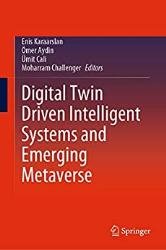 Название: Digital Twin Driven Intelligent Systems and Emerging Metaverse
Название: Digital Twin Driven Intelligent Systems and Emerging MetaverseАвтор: Enis Karaarslan, Ömer Aydin, Ümit Cali, Moharram Challenger
Издательство: Springer
Год: 2023
Страниц: 348
Язык: английский
Формат: pdf (true), epub
Размер: 42.1 MB
The notion of Digital Twins represents a new stage in smart system development that has already shown to have a huge impact in recent years. This new topic has been made possible and accelerated by the developments and integration of various technologies such as the Internet of Things, sensor technology, Artificial Intelligence, Data Science, and Machine Learning. As a result, a digital replica with rich representations of physical entities can be developed that maintains connectivity with the physical entity and enables living monitoring, control and simulations for intelligent decision-making. Rather than relying on direct observation and on-site manual tasks, digital twins provide remote control of processes based on (near) real-time digital information. This idea of a smart, connected digital replica offers innovative solutions to various problems in a broad range of application domains, including manufacturing, aerospace, smart farming, health care, and the automotive industry. Responsible innovations using digital twins can increase leverage and productivity and help create unprecedented value.
Clearly, the digital twin concept is not just a temporary hype but a long-term trend affecting an increasing number of application areas. The concept can be explained from a rationally sound, historical perspective and is part of the ongoing digital transformation process. However, despite its prevalence and growing popularity, there still seems to be a lack of understanding and consensus on the core concepts and implementation of digital twins in various application domain contexts. New concepts are validated, further developed and accepted through lessons learned from real case studies and experience in the practical context. Yet, while the digital twin concept has been proposed earlier in history, its application in a broader context is relatively new. Moreover, the number of applications reported on digital twins is limited to support further reflection on digital twin concepts and therefore help to learn from recent experience and increase understanding beyond the level of hype. Therefore, we need more insights into the diverse applications of digital twins concepts and reflect on the best practices for effective, responsible innovation. Of course, this is no easy task, given the multidisciplinary and interdisciplinary nature of digital twins. Developing digital twin-based systems requires a holistic systems engineering approach where multiple disciplines and often conflicting stakeholder concerns must be considered.
In the hardware design of the nodes operating in the WSAN, the Arduino platform has been used due to its low cost, versatility, and extensive open-source support. On this basis, all of the SNs and ANs have been built on the Arduino Uno board using several electronic components. Arduino Uno has a Microchip ATmega328P microcontroller with 2 KB of SRAM, 1 KB of EEPROM, and also 32 KB of flash memory to store the program codes. Additionally, the low-cost nRF24L01 transceiver module has been also used on hardware design of the SNs and ANs to allow wireless networking in the WSAN. The nRF24L01 transceiver operates in the unlicensed 2.4GHz, and the band baud rate can be changed from the 250 kbps to 2 Mbps. To reach long distances from greenhouse to local server, the CNs and the BN have been equipped with an nRF24L01+ transceiver module, which has a power amplifier (PA), and a low noise amplifier (LNA) as well as an external antenna on board.
Digital technologies are slowly but surely becoming a norm in daily life. Many traditional ways of doing things, such as monetary exchange, have seen completely new ways of shifting people to use different models. Digitalization of various industrial verticals such as energy, healthcare, smart cities, manufacturing, transportation, and supply chain inevitably triggers massive and fundamental changes in society. Artificial Intelligence (AI), distributed ledger technology (DLT), cloud computing, 5G, robotics, and Internet of Things (IoT) are among the most promising enabler of Industry 4.0 technologies. Extended reality (XR), as an overarching technology framework that accommodates augmented reality (AR), virtual reality (VR), and mixed reality (MR), plays an interface and gateway role between the real and the DT worlds.
This book covers the notion of the digital twin, which has the potential to alter the way systems are governed and manufactured. It also addresses the metaverse as an emerging technology with its roots in literature, cross-platform avatars, and artificial intelligence-oriented cybersecurity issues. The untapped potential of the metaverse and digital twins as enabling technologies for the next-generation industries is emphasized in various chapters.
This book provides a timely and complementary contribution to current knowledge of digital twins, with valuable information on key concepts, concrete applications, and a vision for the future.
Contents:
Скачать Digital Twin Driven Intelligent Systems and Emerging Metaverse
